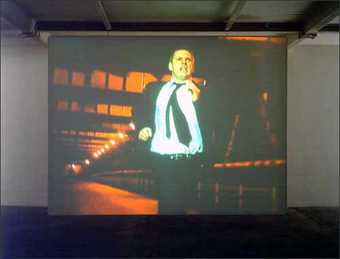
Willie Doherty RE-RUN (details) 2002
Video installation with projection on two screens
Courtesy the artist, Matt's Gallery, London and Alexander and Bonin, New York
Willie Doherty’s work
Derry (also known as Londonderry) is a city synonymous with the Northern Irish conflict. The religious and political divisions there are epitomised by the contested nature of the city’s name. Much of Doherty’s work refers to an undercurrent of fear, oppression and uncertainty that for many has been a daily experience of life in Northern Ireland over the last three decades, whilst revealing a deep mistrust of the journalistic medium. Through photography and video, he adopts documentary codes and the strategies of film noir cinema, to undermine the boundaries between perception and memory, truth and fiction, creating highly poignant open-ended narratives.
The juxtaposition of language and image lies at the heart of Doherty’s practice. He first came to prominence with a series of black-and-white photographs, begun in 1985, which revealed how words can manipulate our reading of an image. By juxtaposing images of landscapes, devoid of human presence, with suggestive texts he offered opposing interpretations, challenging mainstream depictions of the Northen Ireland conflict. In his later video works dual meanings are articulated through the subtle balancing of the visuals and soundtrack. For example, The Only Good One is a Dead One 1993, Doherty’s first video installation, comprises two visual sequences filmed from the interior of a car at night. The scenes are projected at right angles to one another and accompanied by the voiceover of a man who switches constantly between the positions of victim and stalker. The formal presentation of the work echoes this dichotomy, so that the viewer is unable to view both screens at once, a strategy Doherty has repeated in subsequent installations.

Willie Doherty
RE-RUN 2002
Video installation with projection on two screens
Courtesy the artist, Matt's Gallery, London and Alexander and Bonin, New York
While still rooted in his daily experience of sectarian division, Doherty’s recent art has begun to transcend its political specifics to explore wider notions of identity, memory and truth. Extracts from a File 2000 is a set of forty black-and-white photographs shot at night in Berlin. The unpopulated scenes are steeped in darkness with occasional architectural details, such as a window or a passageway, defined by artificial light. The images evoke a sense of paranoia and suggest covert surveillance activity. Re-Run 2002 (shown at the XXV São Paulo Bienal and the Irish Museum of Modern Art, Dublin in 2002, and included in the Turner Prize exhibition) shows a man running along a bridge at night, projected onto two screens opposite one another. On one screen he runs towards the viewer and on the other he runs away, in an eternal silent loop. Without contextual cues, the man becomes a universal figure, caught in a perpetual no-man’s-land, never reaching his destination or escaping his pursuer.
